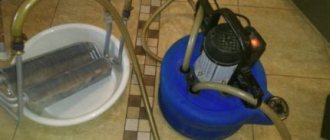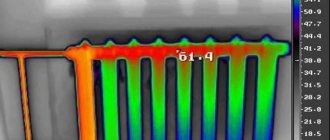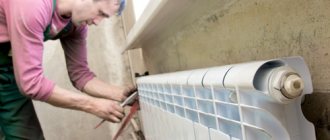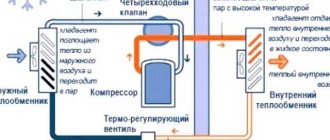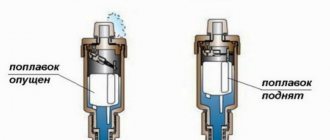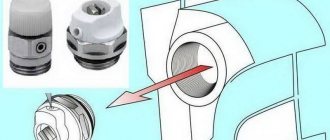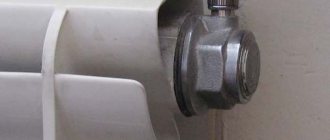Before starting the heating system, it is important to properly prepare it. If a person lives in a city high-rise building, this problem is unlikely to affect him. After all, housing office employees are responsible for carrying out such a procedure. But the owners of the private sector run the heat themselves. But even during the heating season, the batteries can heat poorly, and in some places they can even be cold. The system is probably congested.
In any case, you need to know how to bleed air from a heating radiator in order to avoid situations associated with ineffective operation of the equipment. Why an air lock occurs, its consequences for the operation of the heating device, what methods are available to remove it - you can learn about all this by reading the article.
Why is an air lock in the radiator dangerous?
If there is air in the battery, nothing good will come from it. Excess air is an obstacle to the normal functioning of the system. It can also cause corrosion on the walls of the radiator.
If a circulation pump is installed in the circuit, an air lock may also disrupt its operation. When the system is functioning correctly, the plain bearings on the shaft of the pump unit are constantly in the water. And in the presence of air, a “dry friction” effect occurs, which negatively affects the sliding rings and can damage the shaft. Therefore, it is important to know how to remove air from your home heating system. Timely measures will help prevent damage to the heating network.
Bottom Filling with Administrator Access - Air Lock Removal
It’s one thing if the problem can only be solved from your own apartment or by contacting specialists. It’s another matter if you can play the role of a specialist yourself, for example, by gaining access to the basement.
The solution to the problem in this case is as follows:
- Before removing air from the heating system, it must be bypassed, for which the heating valve is first closed and the sewer discharge located underneath is opened;
- After completing the previous steps, the system should be given about 5-10 minutes to release air;
- If the desired effect is not achieved, the system must be turned in the opposite direction;
- After bleeding the air, you need to close the vent and return all valves to their original positions so that the heating circuit continues to function as normal.
Individual risers with which problems have arisen can also be transferred from the basement level. To do this, it is enough to close the valve of one of the connected risers and open the discharge. The probability of successful bleeding of air in this case is quite high, and if one of the risers is used as an idle pipe, then the work will certainly be crowned with success.
Even if plugs are installed on the risers instead of vents, there are a couple of ways to get rid of an air lock in the heating system:
- The first option is to shut off both risers, reset them, and then replace one of the plugs with a ball valve with a male-female thread. Of course, this option will require the faucet itself - but its cost is low, and such costs are certainly worth it so that the heating system can continue to operate.
- For the second option, you need to close the valves located on the risers, and then unscrew one plug. The riser is put into reset mode, stops, and then the previous operations are repeated in reverse order. This method of bleeding air can only be used when the coolant temperature is below 45 degrees - otherwise the person performing this work may be seriously burned.
How can you tell if there is an air lock in the battery?
Before you bleed air from the heating system, you need to figure out why it forms in the circuit and how to understand that there is an air lock in the radiator. Most often, excess air accumulates as a result of improper filling of the system with water. The reason may also be the result of errors made during installation. Low pressure in the circuit, low-quality coolant with the presence of dissolved oxygen can also lead to airing.
An air lock can also occur under the following circumstances:
- The components of the system are not tightly connected. As a result, air from outside is sucked into the battery.
- There is no air vent or there is one, but it does not work correctly.
- Repair work was carried out to replace locking mechanisms, risers, and heating devices, during which air entered the system.
The following signs may indicate that excess air has accumulated in the system: hissing and gurgling sounds in the battery, the quality of heating decreases, heating becomes uneven, and the radiator may be cold in areas where there is air.
Such situations are not uncommon. Surely every owner of an apartment or private house has encountered a similar problem. Therefore, it is important to understand how to remove air from the heating system at home, especially since doing it yourself is not at all difficult. It should be noted that most often an air lock forms in batteries that are installed on the upper floors of the house.
Important! Sometimes the cause of a plug is a poor quality radiator.
In this case, no matter how much excess air is released, it will form again. And the reason lies in the fact that the material from which the battery is made promotes the formation of gases. There is only one way out of the situation - buy a new radiator. Therefore, it is better to immediately purchase heating devices from reputable manufacturers.
How to avoid air locks
If the heating main is made in accordance with the requirements of GOST and TU (technical conditions), then the appearance of air masses in it is minimized. Another condition to prevent this phenomenon is the correct process of filling the system with water. It has its own characteristics for open and closed heating circuits.
Open circuit
The diagram of an open heating circuit gives an idea of the order in which such a system should be filled with water after flushing. At its highest point there is an expansion tank, and in it there is a special pipe. Its purpose is to protect the highway from overflow.
Such a contour is filled in as follows:
- At the lowest point there is a shut-off valve, through which cold coolant is supplied to the circuit.
- The heating boiler is switched off before filling the system.
- After this, filling of the contour begins. The incoming valve at the bottom of the circuit opens in such a way that the coolant flows in very slowly. In numerical terms, this is expressed in a ratio of 1:3. This means that the valve only needs to be turned back one third of the inlet diameter of the pipe.
- Filling continues until the coolant flows through the overflow hose. Then the water tap is closed.
- Then, air vents are opened on all radiators to ensure high-quality filling of the system.
- The boiler is reconnected. It is advisable to open its taps very slowly.
- The next step is to add coolant at the same slow pace, with the expansion tank filled to 60-70%.
- The operation of the heating system must be checked.
- The boiler is turned on for heating.
- Radiators and pipes are inspected to identify areas where there is no or low heat. This indicates a blockage in the heating line.
- Having identified the cause of airing, the procedure is repeated.
In the first week after connection, the operation of the system is carefully monitored: the water level in the expansion tank, as well as the condition of the radiators and pipes. If necessary, this will allow problems to be resolved quickly.
Filling closed systems
In a similar way, a closed type system is filled with coolant. Water is also supplied to it in a slow flow through a special tap. You can fill the heating system with water yourself.
You should proceed according to the following scheme:
- To perform the procedure, you need a device to measure pressure in the system - a monometer.
- The supply of coolant into the pipeline begins.
- At the same time, pressure is monitored. When it reaches just over 1.5 bar, the supply is turned off.
- Now you can bleed air from all radiators through air vents. In this case, the pressure in the system should begin to decrease.
- The coolant is added in doses to the circuit to maintain it at the required level.
- When the air is completely bled and the line is filled with coolant, the pressure must correspond to the norm. It depends on the specific equipment - from 1.5 to 2.0 bar.
It is optimal to fill a closed contour together with an assistant.
Technology:
- The first bleeds air masses from the radiators.
- The second controls the pressure level in the heating system. If necessary, adds or reduces the feed intensity.
- The first gives a signal about the release of air from the system.
- The partner brings the pressure to the set value.
- The supply stops.
How to remove excess air from a battery?
Before you bleed air from the heating system, you need to thoroughly understand the features of this procedure and prepare all the necessary tools and materials. Let's look at how to remove air from the heating system in more detail. For this work, you will need a special key with which you can open the air valve on the radiator.
A radiator wrench is best. It is sold at any hardware store. If a modern battery is installed, you can take a simple screwdriver. It is also necessary to prepare a container into which the coolant will be drained. And also have a couple of rags nearby in case of unexpected situations.
The algorithm for how to properly bleed air from the heating system is given below:
- Inspect the battery and find a small valve (or Mayevsky tap, as it is most often called). Install it at the top of the radiator. Sometimes there are several such devices. But often they get by with just one valve.
- Turn off the tap until you hear air hissing. You must unscrew it carefully and smoothly.
- Place a container under the valve.
- You need to wait until all the accumulated air comes out. When the water comes out in a thin stream and stops bubbling, it means that the air has left the system. Some experts advise draining about 2-3 buckets of water after water without gases begins to flow. This is done for reinsurance so that you don’t have to perform similar operations again.
- Turn the tap back on.
In addition to Mayevsky taps, automated air vents are often used for heating systems, which bleed off excess air on their own. Such automatic units are compact and reliable. But at the same time you need to be extremely careful. After all, the valve operates without supervision. And the slightest violation in the process can cause flooding of the attic or riser.
Some nuances
There are situations when craftsmen, when installing a heating system, do not install special valves to release excess air. Let's look at how to bleed air from a heating battery in this case. To work, you will need an adjustable or gas wrench. Use it to unscrew the plug. This needs to be done very slowly. Sometimes the plug won't come off. Most often this happens if the battery is cast iron. In this case, you need to apply a special lubricant to the threads and try again after some time.
When the plug is unscrewed, the same algorithm of actions is performed as with a regular tap. When the plug is screwed into place, you must remember to wrap either FUM tape or flax around the thread. This will avoid leaks and make the connection tight.
If air has accumulated in the heating system of a private house, the water will have to be drained using an expansion tank.
This container is always located at the highest point of the heating system. When the water is drained, you need to wait a little and then unscrew the tap on the expansion tank. Usually, when the battery temperature rises, the plug comes out on its own. If such actions are unsuccessful, then the water in the circuit should be brought to a boil. In this case, the plug will definitely come out.
How often should I bleed?
Knowing how to bleed air from a heating system can prevent and solve many problems. But how often should such a procedure be carried out for preventive purposes? As a rule, this should be done at the beginning of the heating season. Twice is enough (the first time for checking, the second for control). Of course, if the system has defects or is faulty, then the number of descents may be greater.
If the apartment has aluminum radiators, then before starting the system it is necessary to drain the water. This will help increase battery life significantly.
How can you bleed air?
Forced circulation systems use a small air plenum at the top for venting. However, it can only be vented if the supply pipe is at an angle in the direction of flow of the coolant.
In this case, the air pockets that rise with it will exit through a series of special valves.
Today, the use of manual and automatic methods is more often used to bleed air and enter water into the system. Hand-held devices (Mayevsky taps) are distinguished by their compact dimensions
Preventive measures
Of course, knowing how to vent a radiator is important and necessary. But it is better that airing of the system occurs as rarely as possible. It is better to prevent this situation and install an air vent.
At the moment, air collectors for heating systems can be of two types: manual (represented by the Mayevsky crane) and float-type (or automatic). Each of the above types can be installed in various places where there is a risk of air pockets. The configuration of the Mayevsky crane is traditional. Automotive air vents can have an angular or straight design.
In order not to rack your brains about how to ventilate the heating system, it is imperative to install an air vent on each radiator.
Manual type air vent
Manual air vents are usually mounted on the front side of the radiator. With their help you can easily bleed off excess air. It is enough to have only a special key. The performance of such devices is low. Therefore, such an air collector for the heating system is installed only for home use.
Automatic air vent type
As for automatic air vents, they operate autonomously. There is no need to unscrew or open anything. The device does everything on its own. They are mounted strictly in a horizontal or vertical position. But it must be said that such a valve for bleeding air from the heating system has one drawback - high sensitivity to various types of contaminants. Therefore, you will need to additionally install a filter that will clean the device from mechanical contaminants.
Important! If air has formed in the heating system, you should find out the cause of this situation. Especially if such problems have not arisen before. It is important not just to remove the airlock, but to take all measures to prevent it from appearing again. Therefore, it is necessary to check the device for leaks. Perhaps somewhere the nuts should be changed or the bolts tightened, or the joints should be sealed better. Or perhaps the air vent is installed incorrectly or the automatic air separator for heating has failed.
Signs of air in the system
The accumulation of air in the heating system and the need to remove the airlock can be determined by the following signs:
- There is noise in the radiators. If the sounds resemble gurgling, then we confidently state the fact that air has appeared in the system;
- Batteries warm up unevenly. If you pay attention to the heat output of the radiator, it will immediately become clear what the main cause of the problem is. In addition to the dirt present inside the battery, an air lock may appear. The pipes remain hot, and the temperature in the radiator decreases slightly;
- A pressure drop can serve as a signal to bleed air in the heating system. In this case, it is necessary to carefully check the pipes for their integrity and the tightness of the joining areas and welds.
The signs given here are quite sufficient to understand that the system should be de-aerated.
Bottom line
To summarize, we can say that the problem of airing the system is quite urgent. It can occur in urban high-rise buildings and in private homes. There can be many factors behind the formation of excess air. It is very important to establish the true cause and know how to bleed air from the heating radiator correctly so that similar situations do not occur in the future.
The installation of special air vents also plays an important role in the proper and efficient operation of radiators. By installing such a device, the owner of a house or apartment will be able to forget about the problem of air locks, save time and money, and also extend the service life of the entire heating system.
